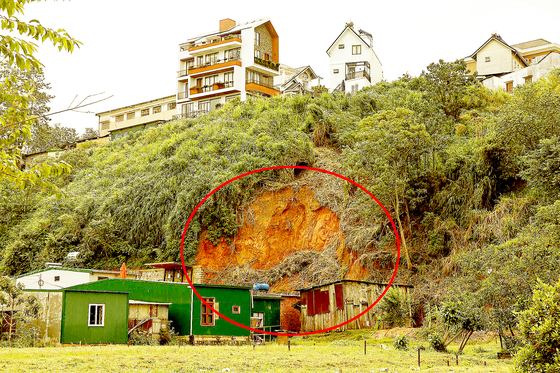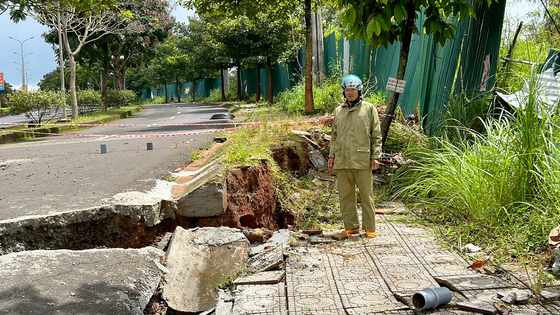 |
The hill in Ward 3, Da Lat City is partially eroded, threatening many houses above but has not been addressed and warned by the authorities. |
Landslides are of great concern among people in the Central Highlands and South Central provinces whenever the rainy season comes. In recent years, many serious landslides have taken a heavy toll on people’s lives and property, cutting off arterial roads.
Rampant landslides
Recent prolonged heavy rain in Dak Nong province caused many serious landslides, damaging many houses, crops, and key construction projects. In Tuy Duc District, on August 1, there were many soil fracture locations extending over 200 meters in Bu Krac, Quang Truc Commune. By the morning of August 5, the soil fractures had extended to more than 1 kilometer and showed no signs of stopping. When it comes to the landslide on Ho Chi Minh road, the section through Nghia Thanh Ward (Gia Nghia City, Dak Nong Province), subsidence is taking place seriously, where the roadbed collapsed with a depth of nearly one meter. Many houses were cracked, as the ground below was extruded and the floor was blown up.
Meanwhile, the Dak N'Ting Irrigation Reservoir Project (invested with a capacity of more than 1.2 million cubic meters of water in Quang Son Commune, Dak Glong District, Dak Nong Province) still shows signs of serious subsidence. According to observations, in this project, the concrete of the bridge deck and the two sides of the roof reinforcing upstream and downstream were cracked. This can also be seen in the earthen talus roof of the downstream, whose cracks are about 20 meters long. To ensure people’s safety, the local government has urgently evacuated more than 100 households with hundreds of people out of the landslide risk area.
 |
The section of Ho Chi Minh road through Nghia Thanh Ward (Gia Nghia City, Dak Nong Province) is seriously eroded. |
According to Mr. Le Dinh Tuan, Chairman of Quang Son Commune People's Committee, dozens of households are living downstream of Dak N'Ting irrigation lake; therefore, a break in the dam can lead to devastating consequences. Along with the urgent relocation of households, the local government cooperates with functional agencies to survey and address the cause of the landslides, thereby coming up with suitable solutions.
In Lam Dong Province, since the beginning of the year, there have been five cases of landslides, killing nine people and injuring four people. Landslides accompanied by heavy rains, floods, and tornadoes have damaged 235 houses, six bridges, two schools, four irrigation works, and hundreds of meters of residential roads. Most recently, at the end of July, after many days of heavy rain, a landslide at Bao Loc Pass (an important pass on National Highway 20) buried a traffic police station, killing three traffic police officers and a resident. The landslide also cut off traffic through Bao Loc Pass for several hours.
Previously, in Hoang Hoa Tham Alley, Ward 10, Da Lat City, there was also a landslide that killed two people as the embankment of the construction project collapsed after heavy rain. With the steep and divided terrain, as well as frequent landslides in the rainy season, Lam Dong Province has currently identified 163 places at risk of landslides, with underlying threats to urban areas with high population density.
In Binh Thuan Province, for the past several days, people living on both sides of DT 719 road (a coastal arterial route connecting the southern tourist areas of Binh Thuan Province), have continuously witnessed the road surface covered by soil, sand, and water accompanied by red mud spilling down from the hill, which seriously affected people's lives, tourism and traffic.
The recent heavy rain has also subjected National Highway 55, the section crossing Da Mi Commune, Ham Thuan Bac District (Binh Thuan Province) to a series of serious landslides. The situation is worsening, with increasing frequency, which is threatening people’s lives and traffic, said Mr. Nguyen Anh Toan, Chairman of Da Mi Commune People's Committee.
According to the Department of Transport of Binh Thuan Province, up to now, there have been about 43 landslides in the above area, of which 7 are heavy landslides, causing local traffic congestion.
Similarly, Tu Mo Rong, Kon Plong, and Dak Glei districts in the Central Highlands province of Kon Tum are prone to landslides in the rainy season. In fact, a section of the Mang Roi bypass (Tu Mo Rong District) is crumbling, causing soil and rocks to overflow onto the road surface. The bridge on provincial road 678 through Dak Na Commune (Tu Mo Rong District) is also flooded at times, inhibiting people’s daily commuting.
Emergency response
According to Mr. Nguyen Ha Loc, Deputy Director of Lam Dong Province's Department of Agriculture and Rural Development, one of the causes of landslides in the area is that in June and July 2023, heavy and prolonged rainfall weakened the ground. In addition, with high-sloped terrain and weak soil structure, mainly basalt red soil, and alluvial soil, there is a great risk of landslides when prolonged rain occurs.
In response to this situation, according to Mr. Nguyen Ngoc Phuc, Vice Chairman of Lam Dong Provincial People's Committee, the committee is currently assigning districts and cities to review and accurately identify each location at risk of landslides, then build a map of the specific location, with the number of inhabitants, the risk level, and the solutions.
Regarding the situation of soil, sand and red mud continuously spilling down the road DT 719, Mr. Huynh Ngoc Thanh, Deputy Director of the Department of Transport of Binh Thuan Province, stated that as green trees had been removed to make room for human activities, whenever there was heavy rain, the soil and sand would overflow into people's houses and roads.
At present, Binh Thuan Province is researching to create large sluice gates to release the amount of sand and red mud that overflows. In the long term, a plan to build embankment walls to prevent landslides is needed, but as the cost is too large, it has to wait for the official policy.
Regarding the consecutive landslide incidents that occurred on National Highway 55 crossing Binh Thuan Province, the Provincial Department of Transport has proposed the Road Administration of Vietnam to report to the Ministry of Transport, so that an emergency situation of natural disasters is announced. At the same time, it is recommended that the Road Administration of Vietnam issue an urgent construction order and a policy for the Department of Transport to organize the implementation.
Mr. Vo Trung Manh, Chairman of the People's Committee of Tu Mo Rong District, Kon Tum Province, attributed the high susceptibility of landslides in the area to its many hills and mountains, as well as the semi-sandy soil composition. Currently, there are about 120 households in the district at risk of being affected by landslides. In the rainy season, the district will relocate these households to a safe place.
Mr. Vu Van Thuan, Deputy Director of the Kon Tum Department of Transport, said that road erosion in the rainy season is a concern of the industry. In recent years, storms have caused landslides on many roads, resulting in heavy damage. For example, in this year's stormy season, many roads in Sa Thay and Dak Glei districts, managed by the department and local authorities, have been eroded.
According to Dr. Vo Hung, Head of Forestry Department, Faculty of Agriculture and Forestry, Central Highlands University, the cause of cracks is prolonged heavy rain, leading the soil to become heavy with water, reducing its strength, resulting in danger of landslides.
Soil fracture occurs in hilly, sloping areas and areas that have been deforested. This can be seen in the landslide at Bao Loc Pass, which was formerly a forest and was invaded by people to grow durian. For agricultural crops, the roots are only in the surface layer and not as deeply rooted as forest trees, so they lack the ability to retain soil, said Dr. Hung.
























